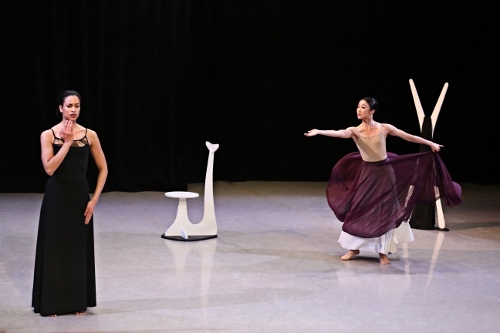|
 |
|
|
 |
 |
The January Graham/Deconstructed Series (January 15-16) focused on the partnership between choreographer Martha Graham and sculptor-designer Isamu Noguchi. Two of their collaborations, Graham’s “El Penitente” (1940) and “Hérodiade” (1944) with Noguchi’s props, were presented in a rehearsal run-through at the intimate Martha Graham Studio Theater. Introduced by Janet Eilber, Artistic Director of the Martha Graham Dance Company, she explained that both these choreographies are great examples of Graham’s collaboration with Noguchi, which spanned almost 50 years (they met in 1926), during which time he created more than 20 “landscapes” for the Company. “They discovered that although they were working in different art forms, both were searching for the elemental shape, whether in movement or sculpture that would provide their viewers with what they called the shock of recognition, a term borrowed from their friend Buckminster Fuller,” said Eilber. Eilber stated that “El Penitente” was inspired by a sect of Native Americans who believed in penitence through physical punishment. “It’s not a straight reenactment. Martha wanted something more complicated,” she said. “It’s designed as a play within a play,” in the manner of old mystery plays. The three characters are itinerant players, so the work doesn’t have a set but relies on portable props, Eilber explained. During the 17-minute piece, they don different color costumes, robes, veils and headpieces, including the startling headdress and crown of thorns worn by the Christ Figure, to reenact vignettes from the Bible. In the fourth of the ten vignettes, a pile of sticks transforms into a Death Cart, a symbol of sin, which the Penitent painstakingly and dramatically pulls across the stage with a rope. There’s a wooden cross, with a white fabric draped over it. Initially used as a scene changer, it is eventually the Penitent’s cross to bear and crucifixion. “The simplicity of Noguchi’s props coordinated with Martha’s primitive style of movement in the work,” said Eilber. “They are often two-dimensional, archaic and have a puppet-like quality. They sometimes look like frescoes or icons on the side of an adobe church.” The Penitente was profoundly portrayed by Lorenzo Pagano; the Christ Figure, was the majestic Lloyd Mayor; and the aspects of Mary as Virgin, Magdalen and Mother, were skillfully performed by Marzia Memoli in three emotionally diverse roles. “Hérodiade,” a duet for two women, is “a deep dive into the psyche of the lead woman,” said Eilber. It was inspired by the (ca.) 1864 poem of the same name by French symbolist Stéphane Mallarmé, about the Biblical tale of Salomé and the decapitation of John the Baptist. “Don’t look for them here,” declared Eilber. “Martha has abstracted and stripped the ideals of the poem down.” “However,” she continued, “some momentous event is about to happen. The lead character [A Woman] is on a precipice drawn to embracing the unknown, dedicating herself to her own vision. Her Attendant perhaps represents the restrictions of family, religion or society, trying to soothe or mollify and convince her otherwise.” Noguchi was tasked with placing a mirror, a chair and clothes rack, which he created as stark white sculptural forms. He wrote, “Salomé danced before her mirror. What does she see, her bones, the potential skeleton of her body. The chair is like an extension of her vertebrae. The clothes rack the circumscribed bones on which is hung her skin. This is the desecration of beauty and the consciousness of time.” Also writing about them, Graham said, “What he brought me was a haunting evocation. Deep within the bones was placed a small object, a bird. I sensed it was Hérodiade’s heart, vibrating and exposed to light. There’s a constant focus on that piece. Whenever I danced Hérodiade, it was always to that animating force that I moved across the stage. It was for me the core of Isamu’s heart as well, that part of each artist, which as he becomes one with the sacrificial animal he exposes to the world.” The piece was brought to life by the ever-amazing Peiju Chien-Pott as the tortured, indecisive Woman and by the impressive Natasha M. Diamond-Walker as the steadfast Attendant. The Graham Studio Series offers audiences a behind-the-scenes look at the Company’s works. Tickets can be purchased online at www.marthagraham.org/studio series. Tickets include a glass of wine. These two rehearsal works will be presented, along with other Graham classics and new works, during the Company’s spring season at The Joyce Theater, April 2-14, which celebrates female empowerment and the 100th anniversary of the 19th Amendment. For ticket information, visit www.marthagraham.org/performances or www.joyce.org/performances.
 Photo of Lloyd Mayor and Lorenzo Pagano in Martha Graham’s "El Penitente". Photo © & courtesy of Melissa Sherwood |
|
 Photo of Lloyd Mayor, Marzia Memoli, and Lorenzo Pagano in Martha Graham’s "El Penitente". Photo © & courtesy of Melissa Sherwood |
|
 Photo of Natasha Diamond Walker and PeiJu Chien-Pott in Martha Graham’s "Herodiade". Photo © & courtesy of Melissa Sherwood |
|
 Photo of PeiJu Chien-Pott in Martha Graham’s "Herodiade". Photo © & courtesy of Melissa Sherwood |
|
|
|





